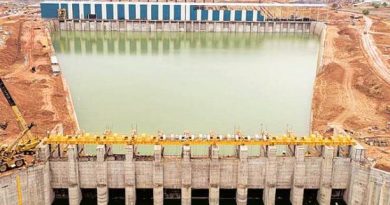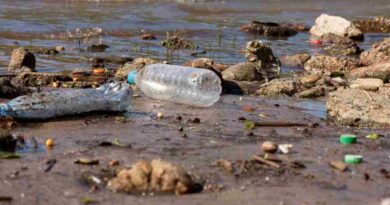Big Fail! India’s Growing Dependence on Bottled Water


At first, this might appear to be a typical growth story from a fast growing economy. But on closer inspection, India will do well to opt out of this ‘race’. We are talking about the size of the market for bottled water.
India’s bottled water sector grew 19% in one year (2016-2017), outpacing other major global markets and is estimated to reach a market value of Rs 16,000 crore by the end of 2018. The growing population, lack of safe drinking tap water and rising health consciousness has contributed to the boom in the water industry. The rise in disposable incomes and growing awareness of the health effects of fizzy/carbonated drinks have also contributed massively to the rise of the sector. Euromonitor reported a Rs 9,010 crore increase in market value for bottled water between the years (2012-2017), that’s an approximate rise of 184% as compared to fizzy drinks, which only grew 56% in the same period. The volume growth of sales is estimated to have risen by 150% from 2012 to 2017 (5.3 billion bottles to 13.3 billion bottles.
Add to these impressive numbers the high growth numbers for the water purifiers market, slated to grow at a CAGR of 18% to almost Rs 25,000 crores by 2025, and you realize the scale of the ‘crisis’.
For India particularly, the rise of the bottled water industry is hardly a sign of progress, as its rise in what remains a poor country simply showcases the inability of the establishment to provide for one of the most basic human necessities to its citizens.
The numbers pale in comparison to our status as having the largest population without access to safe drinking water, with almost 63 million people without access to clean water. Access being the keyword here, as it clearly does not capture the hundreds of millions who are unable to access this clean water, and prefer the safety of frightfully (by per capita standards) expensive bottled/purified water at home.
A recent World Bank report states that 26 million people (rural) have benefitted from government efforts to provide safe drinking water. However, the dire situation in most of the country leads one to seriously question the governmental reforms. In 1949, the Bhor committee highlighted provisions for safe drinking water for 40 years. In 1969 the government launched the National Rural Drinking Water Supply Programme in conjunction with the UNICEF. This program was later renamed as the Accelerated Rural Water Supply Program (ARWSP). In 2009, this program was launched again with various sub-schemes and missions. The recommendations regarding clean water by the ARWSP and the National Water Policies (1987, 2002 and 2012) have repeatedly been overlooked.
This lack of drinking water despite there being numerous programs is traceable to the lack of an adequate budget allocated to the cause and the poor maintenance and upgradation of existing systems. It was only in 2011 that India formally got a Ministry of Drinking Water and Sanitisation. In 2014, the Ministry of Drinking Water and Sanitisation of India launched its first mission mode program to address the issue of sanitisation but drinking Water is yet to have its own mission. This cussedness on making clean and safe drinking water a priority is costing the country dear. WHO estimates that 1,40,000 children die in India everyday due to diseases caused by dirty water. Delinking safe drinking water from the public health policy has led to the state’s failed response in providing easy accessibility to clean water.
Enter bottled plastic water. It is a known fact that plastic is non-biodegradable substance, hence it is important to highlight the negative impact bottled water has on the environment. Most bottles are made from polythene terephthalate (PET), which is highly recyclable, about the only positive here . Between the crude oil use for making the plastics, to the fuel/energy required for filtering, packaging and transporting the water, these bottles, whatever they promise, can never be truly green. The irony of the situation is the wastage of water in producing “bottled” water. It is estimated that the water wasted is six times the water in a bottle of water. Water essentially is used in the cleaning and packaging that leaves large water footprint. The NGO The Water Project (for the brand Fiji) quoted that 26.88Kg of water goes into making and transporting a 1kg bottle of water and the process uses 0.85 Kg of oil while releasing 562g of greenhouse gases.
In the wake of the increasing environmental effects, how does India really fair in terms of recycling plastics? In a statement released by the government in 2016 claims that India recycled 60% of its plastics. In numbers that means out of the 15,000 tonnes of plastic waste produced, 6000 tonnes remained uncollected and littered around the streets. Almost 0.6 million tonnes of India’s plastic waste is dumped into the ocean making India one of the leading countries to dump plastic waste into the water bodies.
This requires a holistic approach to both the challenge of making water accessible to all, and improving attitudes and the need for bottled water. Especially in urban areas. Heavy users like 5 Stars, and the hospitality needs to be sensitized or even supported to cut back on using bottled water, even as we look at models like London, where the city has started a pilot with 20 free drinking water fountains to cut back on plastic use. The pity is that this was an Indian model too, till rapid urbanisation and premium on every inch of land usurped all the free drinking water spots in cities.
And if that wasn’t enough, readers might do well to remember the recent report that pointed out that in a study, all the leading bottled water brands had microplastics floating inside the bottles. Drink to that, next time.
By Aishwariya Chauhan




